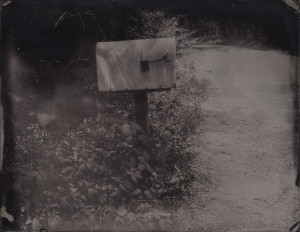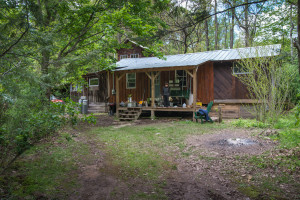On a weekend in May I had the opportunity to attend a workshop for Wet Plate photography. Good friend, fellow photographer, Andrew Morgan, (www.anm76.com), was the other workshop attendee.
Our instructor was Ms. Lisa Elmaleh of Brooklyn Ny. Lisa is an amazing Wet Plate photographer. Check out her work at http://lisaelmaleh.com . Ashley Harte (http://www.ashleyharte.com) and Johnathan Melamed, also very accomplished photographers in Wet Plate and large format work in general provided additional help for us. All are from the School of Visual Arts in Ny City.


They say getting there is half the fun. I found myself winding my way down a few backroads in West Virginia and arrived at Lisa’s cabin which is unique in its own right with a lot of character. We had all the comforts of home that could be offered. The outhouse was off to the side of the cabin and was quite decorative as outhouses go. Andrew is the master camper and I was considered to be the amateur, but I survived the one night sleeping in the back of the cab of my truck. While not totally uncomfortable, there will be more padding next time.
In front of the cabin there was a rather brisk running stream from recent rain that offered a few interesting images to capture in addition to other areas around the cabin.
While I’m not a stranger to large format 8×10 inch cameras we were using for the class; the Wet Plate process is something totally out of my comfort zone and experience. Lisa was extremely patient with us explaining the process for mixing collodion, developer and fixer for the process. In addition covered the safety aspects of working with the chemicals.
I found the hardest part of the process was becoming efficient with the finger dance balancing the tin or glass plate on the tips of your fingers like a waiters tray. Holding the plate by the edges will not allow an even coating of Collodion that creates the emulsion. Once coated the plate is then placed into the Silver Nitrate tank to make it light sensitive.
Following the Silver Nitrate bath the plate is loaded into a modified film holder. Since the material is orthochromatic, its blind to the red spectrum we were able to use a red head lamp while under the makeshift dark enclosure that allowed for easy mounting of the plate into the holder. Then the quick dash to the camera set up and make the image followed by the quick dash back to develop the image.
Some where during the day I mentioned to Andy that its hard to imagine back in the early days having canon fire and musket balls flying past you while you’re trying to coat plates and create images of history.
At the end of the two days of shooting I look back and wish I had shot more. I’m schooled as an old silver halide photographer and transitioned to digital over the years like many others. I’ve been interested in the wet plate process but now have a much better appreciation for the photographers that dive into this process and their ability to provide incredible unique one of a kind images onto metal or glass working out of the back of a truck under a black out cloth.
I almost didn’t go on this outing but thankfully I did and appreciate Andy’s nudging an old guy to go really old school again. Moving around with that large camera and once again looking at images upside down and backwards brought rewards. While my images are not exactly earthshaking, the experience was well worth the time but even more so was the chance to meet and work with such talented artist.
cheers all,
m.







